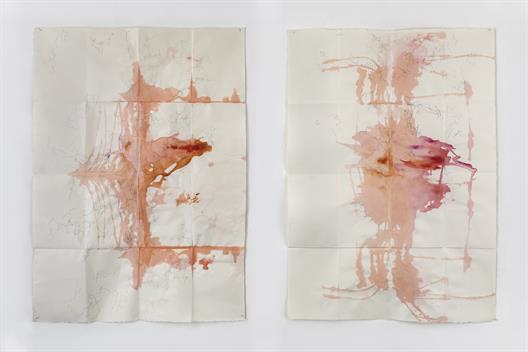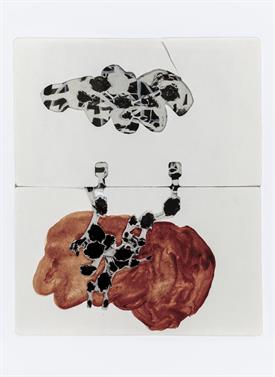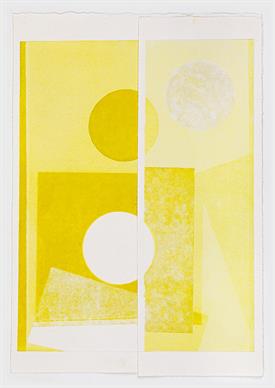Maria Schleiner / Swantje Lichtenstein
Ferkelprojekt
seit 2021 community based project, ongoing.
Maria Schleiner
Werkschau, Kloster Bentlage 04. Februar bis 27. März 2022
Druckvereinigung Bentlage
Ausstellung: "a bit on the side - zeichnung auf nebenwegen", Kaunas, Litauen. 30. September bis 31. Oktober 2021
Meno Parkas Gallery, Rotušė sq. 27, LT-44279 Kaunas, Lithuania
Artland - a bit on the side – Zeichnung auf Nebenwegen / Drawing on Sidepath
Künstlerhaus Dortmund - a bit on the side III / Zeichnung auf Seitenwegen
Diese Ausstellung im Künsterhaus Dortmund wurde von Prof. Maria Schleiner in Zusammenarbeit mit Elly Valk-Vereijen kuriert.

ohne Titel, 2021, jeweils 140 x 100 cm, Wasserfarbe/Tusche, Transferpapier Zeichnungen
|

#3 (Serie von sieben Arbeiten), ca. 15 x 10 cm, Karteikarte, Foto, Wasserfarbe
|
VIELFALT III, Juni bis August 2021
Galerie Münsterland, Emsdetten (Katalog)
zur Ausstellung
VIELFALT II, März bis April 2021
Kunstort Münsterland, St. Barbara Kasernen, Dülmen
zur Ausstellung
"Baltic Bridges. Fabula", Biennale in Kaunas, Litauen. International Watercolour Biennal in Kaunas, Litauen. 17. September bis 18. Oktober 2020 (Katalog) https://www.facebook.com/pg/baltijostiltai.balticbridges/posts/
"Tuning 4" (detail), 2020, Watercolour on thin printing paper, duct tape, 18 cm x 26 cm
Samstag, 28. September von 15-20 Uhr & Sonntag, 29. September 2019 von 11-18 Uhr
Künstlerhaus Dortmund, Sunderweg 1, 44147 Dortmund
Die Künstlerinnen und Künstler des Künstlerhauses Dortmund, dem größten Dortmunder Ausstellungs- und Atelierhaus, öffnen einmal im Jahr ihre Ateliers, und laden ein, einen Blick in die Räume ihrer Kunstproduktion zu werfen. Gelegenheit für interessante Gespräche über Malerei, Fotografie, Skulptur, Installation, Klangkunst, Film, Zeichnung und mehr.
Künstlerinnen und Künstler
Debora Ando, Anett Frontzek, Cornelius Grau, Willi Otremba, Gaby Peters, Dirk Pleyer, Denise Ritter, Alexander Rütten, Maria Schleiner, Jana Kerima Stolzer, Jens Sundheim, Elly Valk-Verheijen, Adriane Wachholz.

Maria Schleiner, 2017
„Vergangene Tage“, III
Farbradierung/Collage
50 x 35 cm (gerahmt)
Das Künstlerhaus Dortmund zu Gast im Kloster Bentlage 13.07 - 09.09.2018Künstlerischer Arbeitsaufenthalt Sigmaringen 01/02/03 2017
Ateliers im Alten Schlachthof, SigmaringenVon Januar bis März 2017 arbeitet Maria Schleiner im Rahmen eines
künstlerischenArbeitsaufenthalts in den "Ateliers im Alten Schlachthof" in
Sigmaringen. Der "Ateliers im Alten Schlachthof e.V." bietet ganzjährig ein
Angebot, das Begegnung und Kommunikation mit Professionalität in den
Bereichen Kunst, Theater und Musik ermöglicht. Die Arbeits- und
Ausstellungsräume des Vereins bieten Künstlern/Innen Freiraum sowohl für
die ästhetische Praxis während des Werkaufenthalts als auch für die
Präsentation.
Die Arbeit von Maria Schleiner konzentriert sich in diesem artist-in-residence
auf zeichnerische Projekte. Kleinformatige und fragile Papierarbeiten sind die
Ergebnisse von Serien, die durch gestische Zeichensetzung und exakte
Nachbearbeitungsphasen entstehen. Dabei werden einfache Formen und
Figurationen repetitiv verwandt, während durch minimale Verschiebungen
ästhetische Differenzen geschaffen werden. Auf diese Weise werden die
Figurationen in ihrer Komposition erprobt. Die Untersuchung abstrakter
Formen, ihrer Beziehung untereinander und zu ihrem Hinter-/ Untergrund
steht dabei im Mittelpunkt. Die ästhetischen Erforschungen in der Zeichnung
werden auf druckgrafische Prozesse übertragen und fortgeführt. Neben
flächigen Arrangements entstehen grafische Arbeiten, die räumliche Fragen
aufwerfen. Die dabei entstehenden Themen und die bekannten Paradigmen
von Figur/ Grund, Zufall/ Komposition, Transparenz/ Opazität, Markierung
etc. handeln vom Erproben und Hervorrufen visueller Erfahrungen. Die
Möglichkeiten der skizzenhaften Ausdrucksweise von zeichnerischen und
druckgraphischen Prozessen werden genutzt und diese Medien auf essentieller
Ebene untersucht, um eigenständige Resultate zu erzielen, die dem/ der
Betrachter/In entgegenstehen können.
| Maria Schleiner is spending an artistic work stay in the "Ateliers im alten
Schlachthof" in Sigmaringen from January to March 2017. The "Ateliers im alten
Schlachthof e.V." provides the possibility for encounter and communication to
professionality in the field of Fine Arts, Performance and Music. The facilities
of the association offer open space to the artists for aesthetic practice as wells
as exhibition.
During this artist-in-residence the focus of MariaSchleiners work rests on
graphic projects. Series are developed by gestural drawings and phases of
exact post-processing, which resultin small and fragile paperworks. Thereby
simple forms and figures are used repetitive, while aesthetic differences are
made by minimalistic shifts. In this way the figurations are being tried in their
composition. In the centre of attention lies the study of abstract forms, their
relationship among each other and to their (back)ground. The aesthetic
studies of the drawings are transferred to graphical processes and continued
from there. Apart from two-dimensional arrangements graphical works and the
issue about three-dimensionality result. The thereby rising issues and wellknown
paradigms of figure/ ground, coincidence/ composition, transparency
/ opacity, marking etc. deal with testing and evocating of visual experience.
The sketchy mode of expression of graphical works and its possibilities are
used and investigated on an essential level to create independent works which
may be opposed to the spectator.
|
Maria Schleiner
Paradise – in construction
13.10. – 13.11.2016
|
|
6th International Watercolour Biennial Baltic Bridges 2016: Challenges and Directions
Solo exhibition by Maria Schleiner (Germany), the grand prix winner of the 5th International Watercolour Biennial Baltic Bridges 2014: Resonances Arts Faculty of Kaunas Collegium, J. Vienozinskis Arts faculty A.Mackeviciaus str. 27, Kaunas, Lithuania
Maria Schleiner eröffnet im Rahmen ihres Praxissemesters im WS 16/17 die Ausstellung Paradise – in construction. am 13.10.2016 in der Faculty of Arts of Kaunas College in Kaunas, Litauen. Die Ausstellung ist Teil der 6th International Watercolour Biennial Baltic Bridges 2016. Auf der 5th Baltic Bridges Biennale, 2014, erhielt Maria Schleiner den GRAND PRIX und wird für ihre künstlerische Arbeit durch die Einzelausstellung auf der diesjährigen Biennale gewürdigt. Farbige, abstrakte Arbeiten auf unterschiedlichen Papieren loten die Möglichkeiten der Form- und Farbsprache aus. Sie bestimmen als klein- und großformatige Formationen den jeweiligen Raum. Die kleinen, farbigen Papierobjekte und Papierarbeiten bilden je ein Ensemble, changierend zwischen abstrakter Formgebung und gegenständlichen Assoziationen. Spielerisches, meditatives Arbeiten verbunden mit konzeptuellen Prozessen künstlerischer Arbeit führt zu ästhetisch vielfältigen Ergebnissen. Die Ausstellung Paradise – in construction. findet in der Fakultät der Künste statt, die nach Justinas Vienožinskis benannt ist, dem Gründungsvater der Kunsthochschule in Kaunas.
Paradise – in construction.
To follow the appearance of things in nature and on the paper engenders a special space in the time created by a calm but concentrated atmosphere of being.
Trailing with the eyes the lines of tree branches and seeing the many ways of their evolvement leads the hand to imaging modalities. Fast and without hesitating commotions of lines and dots, curves and figures are built up on big sized papers. While the work is filled with the movement of many graphic and pictorial elements, it is not meant to assert or to declare; it is supposed rather to be and to remain at once an echo of the plants like they arise and a network of brushstrokes on the paper. To underline this ambiguity the colour appears reduced in different shades of light grey, brown, green. Coincident will be accepted and conceptually embedded. Ledger lines and haphazardly created dots of ink lead to the concept of the design. Gum arabic is used as the vehicle and binder of the watercolour ink. Since it is prepared freshly and partly mixed with other colouring components like the soil it leads to interesting ways of drying on the paper. The finished works are not necessarily presented as single works of art. Instead they might also be covering the walls of the exhibition rooms and may be crawling all over the space, so the viewer may follow the lines and forms expanding over the wall and ceiling. (“Untitled”,2015/16, watercolour, varied in size)
Following with the eyes the lines the brushstroke is leaving on the paper many forms and figures emerge, which are later cut out. Non-representational little objects arise. Their little paper jetties indicate the size of the paper they had been created on. They are combined to installation fields. It gets to be an assemblage of broken bits consisting of vulnerable coloured forms of paper. Shadows and slightly movements of the paper objects complete the impression.
(“Brandenburg, Cumlosen” 2015, watercolour, invisible thread, each object varies in size, ca. 14 x 19 cm)
Tracking with the eyes how the hand is moving over the thin paper in repetitive movements a geometrical pattern of lines and dots evolves. The repeating procedure builds a calm atmosphere of contemplation, a safe haven for the being. It is a constructed paradise. In further procedures the thin paper gets folded and perforated. With scissors some of the forms are cut out but they all find their way back to the emerging work. It is an amusing game of relocation. A play unfolds putting some forms together to piles, stacks, scattering to new regimes. The initially created geometric figures are mixed with scriptural or graphic forms of order. The holes indicate the missing forms and the spectator is asked to unfold the game in front of his/her mental imagery. (“Acquapendente”,2015 / 16, each 35 x 23 cm or 23 x 35 cm)
|